ROSE-BREASTED GROSBEAK discovered by Jamie Partridge on St Agnes Photo by Laurence Pitcher
I managed to get some time off during the day and with the third Pectoral Sandpiper of the year arriving yesterday at Porth Hellick and the possible Tennessee Warbler on Bryher and now the Grosbeak, there must be another yank hiding on St Mary's somewhere.
Instead I had to do with a single Firecrest and 2 Willow Warbler at Lower Moors and in finding a Yellow-browed Warbler and 2 Pied Flycatcher at Trenowth. Of the latter species I had three at Innisidgen with two also at Content where there was a Whinchat and on the lane I kicked a Wryneck that showed very well feeding on a wall. At Porthloo there were 3 adult and a single 1srt winter Mediterranean Gull.
There was a single Firecrest and 2 Willow Warbler at Lower Moors including this bulky looking individual looking like a possible Northern Willow Warbler.
Found this Yellow-browed Warbler at Trenowth
Saw up to 7 Pied Flycatcher including this one at Content
Found this Wryneck showing off at close range at Content Lane
Altogether I had over 20 Chiffchaff
Also saw up to 5 Wheatear
This Ruff was on the airfield (27th) before being flushed by dog walkers. Maybe the only one I see this year.
Two days ago I had this Pied Flycatcher at Newford with another three at Nearby Peace Haven
Yesterday all the Bee-eaters teamed up together on Tresco where there was also a Red-backed Shrike.
I'll finish with BBC propaganda lies again!! On their website: All you need to know about North Korea! The BBC admit that what the have written in this rubbish is pretty inaccurate! All of the BBC currant affairs and news is inaccurate!
As I'm aware, isn't our government stopping us from protesting, boycotting Israel and making strict rules with use on the Internet. Well it's a laugh as we continue to live in fear of North Korea from propaganda of the BBC and western media when we should all be in fear of the physco who is in control of the UK and is funding terrorists and the other physco on the otherside of the Atlantic who is pushing for nuclear war! Yesterday Trump told Hawaii to be prepared for nuclear attack! A siren warning would give the residents 12 to 15 minutes to reach a safe location!! It went on to say that Gene Ward, a State Representative, said that he did not want to be an 'alarmist' but wanted people to be prepared. It's all designed to make people fearful!!
Just have a look at what the The Telegraph said today about North Korea with the headline...
'Chilling graphic shows the spread of radioactive cloud if North Korea detonates nuclear bomb over Pacific'.
It's called 'FAKE NEWS!!'
And here's some more fake news from the BBC...
Nine charts which tell you all you need to know about North Korea
As North Korea and the United States continue to trade threats, we have little idea how the war of words is perceived to the people of North Korea because the regime of Kim Jong-un maintains an iron grip over the population, carefully controlling access to the outside world.
The country is often depicted as isolated and thoroughly out of step with the 21st century. Statistics are hard to get and often based on estimates, but what can they tell us about life in the North?
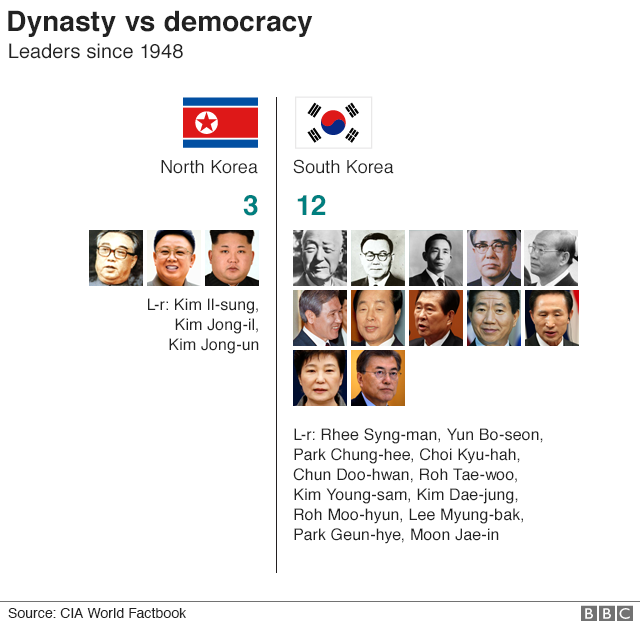
Kim Il-sung effectively founded North Korea in 1948 and his family dynasty has ruled the country ever since, with control passing from father to son.
In the same period South Korea has managed six republics, a revolution, a couple of coups and the transition to free and fair elections. In total 12 presidents have led the country, covering 19 terms of office.
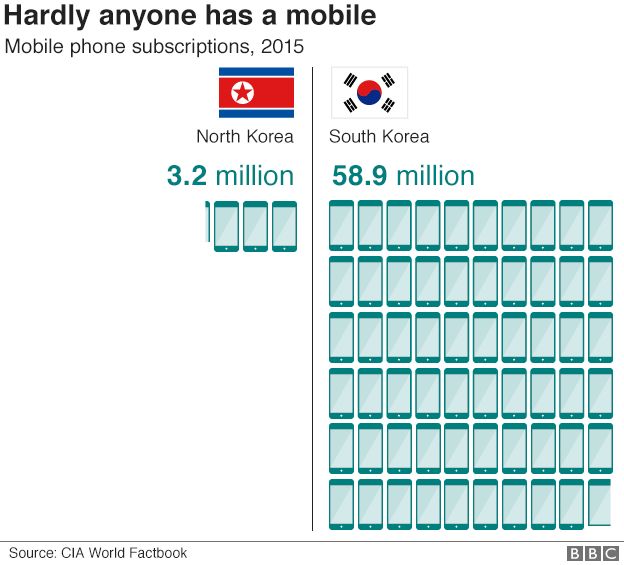
Three million mobile phones might seem like a lot - but in a country of 25 million it amounts to just over one out of every ten people. Most mobile users are likely to be concentrated in the capital Pyongyang.
By contrast, with a population of some 51 million there are more mobile phone subscriptions than people in South Korea.
With effectively a single network, Koryolink, North Korea's mobile market is limited but growing. Originally established as a partnership with Egyptian telecom firm Orascom, it was for many years the only option.
However, in 2015 Orascom discovered that North Korea was setting up a rival network, Byol, and was forced to disclose to investors that it had effectively lost control over the service's three million plus subscribers.
There's reason to be sceptical about those subscriber numbers though.
Research by the US-Korea Institute at SAIS suggests that some growth might be down to North Koreans calculating that it's cheaper to buy an additional subscription than additional air time.
As well as a scarcity of mobiles, the vast majority of North Koreans are only permitted access to the country's 'private internet' - effectively a closed intranet operating on a national scale.
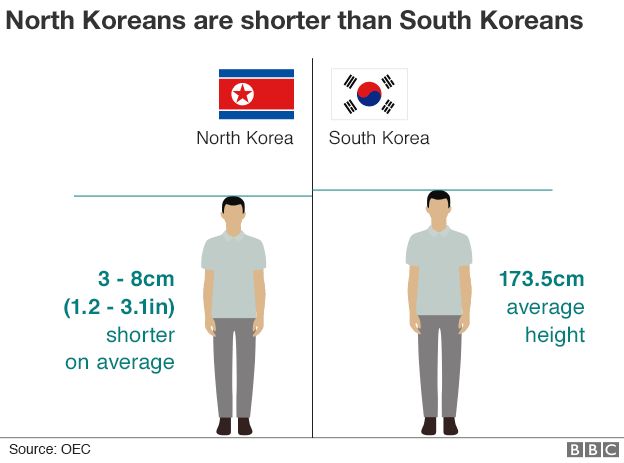
It may sound like an urban myth, but there is some research to suggest that North Korean men are on average shorter than their South Korean counterparts.
Professor Daniel Schwekendiek from Sungkyunkwan University in Seoul studied the heights of North Korean refugees measured when they crossed the border into South Korea and found an average 3-8cm (1.2 -3.1 inch) difference.
Schwekendiek points out that the height difference cannot be attributed to genetics, because the two populations are the same.
He also rejects criticism that suggests that refugees are more likely to be impoverished, and therefore of smaller stature.
Food shortages are thought to be the main factor in why North Koreans are generally shorter.
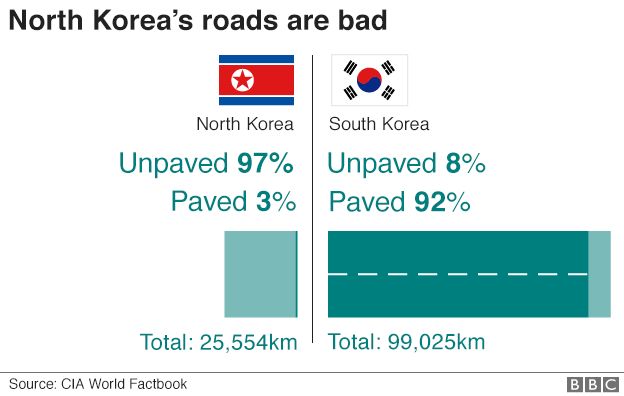
Images from North Korea's capital Pyongyang often show stretches of wide, pristine motorway unoccupied by traffic, but outside the city it's another story.
North Korea has some 25,554 km of roads, according to 2006 figures, but just 3% are actually paved, amounting to a meagre 724km (449 miles).
It's also estimated that only about 11 out of every 1,000 North Koreans owns a car, which means a long queue at the bus stop for most people who need to travel.
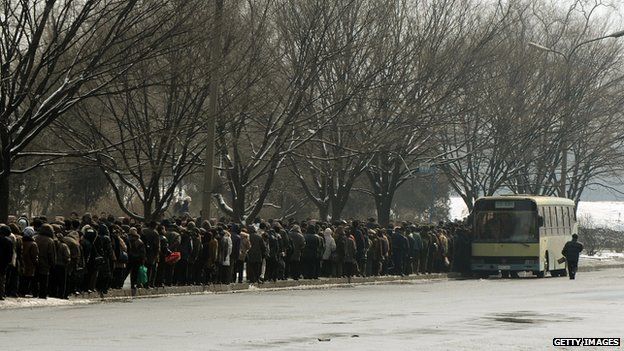 GETTY IMAGES
GETTY IMAGES
North Korea relies on coal exports to keep its economy above water - but it's hard to measure their true value as the data comes from countries receiving the coal.
Much of North Korea's coal is exported to China, which banned imports in February 2017. However some analysts question the nature of the sanction.
"There are folks who track ships and have seen North Korean ships docking at coal terminals at Chinese ports even after the ban. I do believe that China has disrupted coal imports, but not completely," says Kent Boydston, research analyst at the Peterson Institute for International Economics.
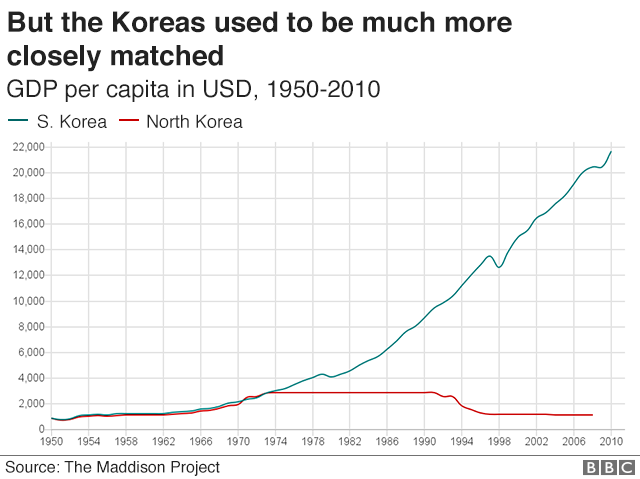
Until 1973 North and South Korea were pretty evenly matched in terms of wealth.
Since then, South Korea has rocketed ahead to become one of the world's leading industrial producers, with companies like Samsung and Hyundai becoming global household names.
North Korea stagnated in the 1980s as the country stuck rigidly to its state-run system.

While North Korea is the 52nd largest country by population, it is considered to have the world's fourth largest army.
Military spending is estimated to account for as much as 25% of GDP, and almost every North Korean man undergoes some form of military training.
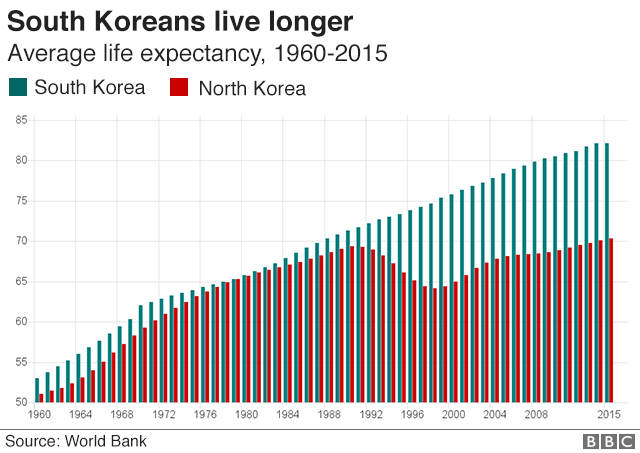
A series of famines in the late 1990s caused a sharp drop in life expectancy in North Korea, but even without that factor, the North lags nearly 12 years behind.
Food shortages persist and are one of many reasons why South Koreans generally live longer.
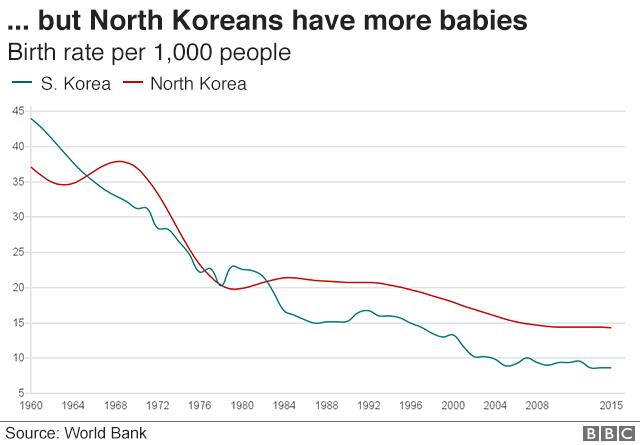
In 2017 South Korea's birth rate hit a record low as the country continued a decade-long struggle to boost the country's birth rate.
It has spent about $70bn (£53bn) handing out baby bonuses, improving paternity leave and paying for infertility treatment.















No comments:
Post a Comment